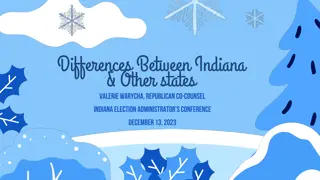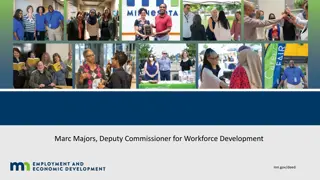Insights from 2022 Indiana Chamber Employer Workforce Survey
The 15th annual Indiana Chamber Employer Workforce Survey presents findings based on 922 responses, highlighting workforce statistics, organizational types, future workforce projections, challenges faced, and strategies employed by Indiana businesses. Key insights include workforce size distribution, workforce expansion plans, talent acquisition difficulties, open positions management, and planned changes for the upcoming year. Challenges such as attracting and retaining workers, government regulations, and inflationary pressures were identified as the top workforce issues faced by employers in Indiana.
Download Presentation

Please find below an Image/Link to download the presentation.
The content on the website is provided AS IS for your information and personal use only. It may not be sold, licensed, or shared on other websites without obtaining consent from the author. Download presentation by click this link. If you encounter any issues during the download, it is possible that the publisher has removed the file from their server.
E N D
Presentation Transcript
2022 Indiana Chamber Employer/Workforce Survey October 2022 1
Employer Survey Background 15th annual survey 922 responses 79% of responses from Owner/Management 16% of responses from HR/Operations Broad industry sector representation 2
# of Indiana Employees 5 or less: 13% 6 to 19: 18% 20 to 49: 18% 50 to 99: 14% 100 to 499: 21% 500 to 999: 6% 1,000 or more: 9% 3
Organization Type For Profit 16% 73% Non Profit 11% Govt./Other 4
Increase Size of Workforce Next 1-2 Years 70% 58% 56% 55% 60% 45% 50% 41% 40% 30% 20% 10% 0% 2018 2019 2020 2021 2022 5
Supply of Applicants Does Not Meet Needs 75% 72% 70% 65% 62% 62% 60% 55% 50% 50% 50% 45% 2018 2019 2020 2021 2022 6
Left Jobs Open in Past Year Due to Underqualified Applicants 80% 74% 70% 60% 60% 51% 49% 45% 50% 40% 30% 20% 2018 2019 2020 2021 2022 7
How are you filling open positions? 1. Left position open 2. Reassigned responsibilities internally 3. Hired underqualified candidate 4. Hired temp workers 5. Hired remote workers 51% 39% 30% 23% 21% 8
Planned Changes in Next Year (2022 vs. 2021) Utilize current employees to perform additional job functions Retraining employees/new technology Expanding remote work Automating/replacing job functions 60% +4 32% 32% 21% +5 +6 +1 9
Is meeting your talent needs a challenge? YES 83% 17% NO 10
Biggest Workforce Challenges 1. Attracting/retraining workers 2. Government regulations 3. Inflationary pressures 4. Supply chain challenges 52% 18% 16% 15% 11
Employer Hiring Challenges? Applicants lack necessary education/skills Applicants unwilling to accept pay offered Applicants not interested in our industry Applicants not attracted to our community 48% 43% 41% 22% 12
External Factors Negatively Impacting Talent Attraction/Retention? Housing Childcare Transportation Community amenities Quality Schools 32% 31% 30% 21% 18% 13
Changing Training Strategy (2022 vs. 2021) Increased investment in training: Increased on-the-job training: Increased online training: Increased time allowed for training: Increased classroom training: 55% +24 55% +22 50% +10 47% +20 25% +17 15
On-Site Education Offered by Employer? YES, we offer onsite classes for our employees 30% Offered during workday/shift 18% Offered outside of workday/shift NO, we don t offer onsite classes for employees 12% 60% Would consider it (if provided at no additional cost) 31% Not considering it at this time 25% 16
Skill-Up Support for Current Employees? Flexible Work Hours 56% +7 Tuition Support/Reimbursement 35% -4 Onsite/Online Instruction 31% +3 Credit for prior learning/experience 12% +6 Prepaid Tuition 10% +2 17
Whats Driving Employer Training Strategy? To help us attract/retain employees To build a more diverse workforce To supplement postsecondary education Can t rely on education/training providers 30% To replace retiring workers 53% 47% 31% 29% 18
Employer-Provided Training + Credentials 2021 3-Yr Trend 38% 13% Industry-recognized credential College degree/credential Credential provided by employer 20% No credential 51% 67% 47% 19
Future Talent: Work-Based Learning 2022 2021 Change College Internships 45% 51% -6 Job Shadowing 43% 27% +16 High School Internships 31% 23% +8 Registered Apprenticeships 14% 18% +8 Pre-/Youth Apprenticeships 12% 21
Employer Support for Tax/Financial Incentives 1. Expanded work-based learning 2. Training that results in a credential 3. Early learning/childcare benefits 4. College savings plan contributions 52% 38% 28% 22% 22
Employee Family/Childcare Support 2022 3-year Change +3 +4 +7 +5 +5 Paid Maternity Leave Paid Paternity Leave Onsite Childcare Childcare Subsidy/Reimbursement Offsite Childcare Partnership 36% 23% 9% 8% 7% 23
Do you/would you consider hiring? 2022 2019 Recipients of public assistance 64% 56% +7 Individuals with physical disabilities 53% 57% -4 Ex-Felons (non-violent offenses) 44% 42% +2 Individuals with mental disabilities 28% 28% +1 Ex-Felons (violent offenses) 10% 7% +4 NONE OF THE ABOVE 7% 18% +9 24
Challenges + Opportunities 25
Human Resources Staff Offers Career Coaching to Employees YES 41% 52% NO NOT SURE 7% 26
HR Staff Dedicated to Strategic Talent Attraction/Development/Retention YES 46% 48% NO 27
Employer Awareness of Next Level Jobs YES 39% Yes, and we actively promote it to our employees. 18% Yes, but we don t promote it. NO 12% 49% No, but interested in learning more. No, and not interested. 38% 11% 28
TALENT PIPELINE PARTNERSHIPS? YES 52% 38% 34% 32% 3-Yr Trend Higher Education K-12 Schools Regional Workforce Boards Community-Based Nonprofits 29
The Hoosier Worker Perspective 30
Workforce Survey Background 2nd annual survey of 600 Hoosiers Between the ages of 18-60 Employed, unemployed and under-employed Not business owners or upper-level management 31
How important is a college degree when it comes to growing in your career? IMPORTANT 74% Very important 28% Somewhat important NOT IMPORTANT 46% 19% Not that important. Not important at all. 15% 4% 32
Would you pursue more education and training if provided FREE by employer/state? 5% More likely Less likely 71% 17% Neither 33
Hoosier Workers Awareness of NEXT LEVEL JOBS YES 20% NO 68% No, but I M INTERESTED in learning more. 38% No, and not interested. 11% 34
Would you pursue more training if your employer encouraged you to do so? YES 80% Definitely Probably NO 37% 43% 12% Probably no 9% Definitely no 3% 35
What education/training support does your employer offer? 31% Flexible work schedule 26% Tuition reimbursement 21% On-site instruction / self-paced online training 16% Career plan assistance 7% Academic credit for on-the-job training or prior work experience 5% Prepaid tuition 41% UNSURE 36
Most influential when deciding to pursue additional education/training? 1. Family and friends 2. My employer (current or most recent) 3. Higher education reps 4. School Counselors/Teachers 5. Community/Faith-Based Orgs 6. Government agencies 69% 48% 42% 38% 37% 33% 37
KEY TAKEAWAYS The need for workforce talent (both quantity and quality) remain top concerns for Indiana employers. (Bigger than inflation, supply chain, etc.) More employers are responding to the talent shortage challenge by strengthening and diversifying their talent strategies. There are significant awareness gaps (among employers + individuals) re: existing education/workforce resources (e.g., Next Level Jobs). Employers are well positioned as effective messengers for encouraging Hoosiers to upskill/reskill and increase education attainment. Engaging employers as co-developers of talent through intentional partnerships with community/education/government orgs is key. 38 38
Indianas Education + Workforce Imperative CURRENT STATE: Indiana ranks 37th nationally in education attainment and 39th in per capita income. FUTURE STATE: Increase Indiana s rankings for education attainment and per capita income above neighboring states and to top 25 rankings nationally. 39 39
Education disparities exacerbate Indianas economic and workforce development challenges. LABOR PARTICIPATION: 62% UNEMPLOYMENT: 2% VS. Less than high school diploma: High school graduates: Some college or associate degree: 2% Bachelor s degree or higher:<1% 7% 4% Less than high school diploma: High school graduates: Some college or associate degree: 66% Bachelor s degree or higher: 43% 57% 73% Source: Indiana Department of Workforce Development, June 2021 May 2022 40
Top 10 Education/Workforce Priorities 1) Early Childhood Education 2) Career Awareness/Engagement 3) Employer Incentives 4) K-12 Education/Workforce Alignment 5) Postsecondary Access 41 41
Top 10 Education/Workforce Priorities 6) Postsecondary Graduate Retention 7) Reemployment Skill-Up Incentives 8) Regional Development Investments 9) Work-Based Learning 10)Workforce Training 42 42























